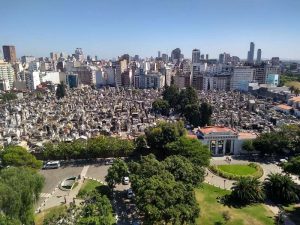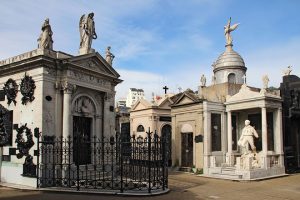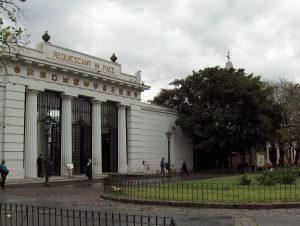There are few names that more readily bring a single city to mind than Evita. And María Eva Duarte de Perón, the former first lady of Argentina—who died in 1952 at just 33 years old—is buried in none other than the Recoleta Cemetery in Buenos Aires. Few visitors to Buenos Aires will skip this important historical spot, and even if the particular story of Eva Perón doesn’t strike your fancy, this fascinating, 5.5-hectare city-within-a-city is worth a visit. Major media outlets routinely call it out as one of the world’s most beautiful cemeteries, and if you have even the slightest passing interest in architecture, art, sculpture, politics or history, there is much to be learned by passing through its gate.
The History of the Recoleta Cemetery
 The cemetery was opened in 1822 by the local government, as a ploy to remove political power from the Catholic Church in Argentina. They seized land from the Recoletos, the order of monks who owned it at the time and who used one of the back gardens as a cemetery. That original cemetery went from being a cemetery centered on the clergy and those close to the Catholic Church, to being public (albeit still Catholic for many years). The first public burial was of a freed slave who died at 15 years of age, followed by an unmarried woman, neither of whom presumably would have qualified for burial there under the original ownership. It remained steadfastly Catholic until 1868, when then President of the Republic Mitre opened it to other religions.
The cemetery was opened in 1822 by the local government, as a ploy to remove political power from the Catholic Church in Argentina. They seized land from the Recoletos, the order of monks who owned it at the time and who used one of the back gardens as a cemetery. That original cemetery went from being a cemetery centered on the clergy and those close to the Catholic Church, to being public (albeit still Catholic for many years). The first public burial was of a freed slave who died at 15 years of age, followed by an unmarried woman, neither of whom presumably would have qualified for burial there under the original ownership. It remained steadfastly Catholic until 1868, when then President of the Republic Mitre opened it to other religions.
But perhaps even more interesting than its religious history, is the cemetery’s design and the social significance of the cemetery. The layout of the Recoleta Cemetery was inspired by the famous Père Lachaise Cemetery in Paris, and was in fact, designed by French civil engineer, Próspero Catelin. It is set up much like a miniature city, with boulevards and avenues, and different neighborhoods, all among abundant vegetation.
Much like other (living) cities, Recoleta is organized along strict social structure, and it is fair to say that homes (in this case mausoleums) located along the main thoroughfare of the cemetery (Los Cipreses) were more coveted than other, farther-flung addresses. Having a mausoleum in Recoleta was one of a trifecta of things that defined the upper echelons of society of the time, the other being their giant manor houses or castles on their estancias (cattle ranches) and their pied-à-terre in the city (though these were also quite ornate) where they stayed when there was a wedding in the city, or perhaps when they came to Teatro Colón to see the opera.
 For many years, the well-seated in Buenos Aires had their city homes in the neighborhoods of San Telmo, San Nicolás (aka the Microcentro) and Monserrat, where reminders of their grand past can still be seen in the elaborate, stately architecture that remains. But a public health crisis, in the form of yellow fever, in 1870 forced them out. At the time, residents were unsure if it was proximity to the river, mosquitos, the new wave of European immigration or living in close quarters that helped spread the disease, but they knew that they and their families were at risk if they stayed in those areas. They therefore looked north to where they had country homes and estates, and moved to the area surrounding the Recoleta cemetery, where ironically, they found better health and living conditions.
For many years, the well-seated in Buenos Aires had their city homes in the neighborhoods of San Telmo, San Nicolás (aka the Microcentro) and Monserrat, where reminders of their grand past can still be seen in the elaborate, stately architecture that remains. But a public health crisis, in the form of yellow fever, in 1870 forced them out. At the time, residents were unsure if it was proximity to the river, mosquitos, the new wave of European immigration or living in close quarters that helped spread the disease, but they knew that they and their families were at risk if they stayed in those areas. They therefore looked north to where they had country homes and estates, and moved to the area surrounding the Recoleta cemetery, where ironically, they found better health and living conditions.
The wealth of Argentina at the time was based on exports, first of cured meat, and later, through the Industrial Revolution, on the export of grains and wool. All of these kept the wealthy of Argentina quite wealthy, and during the city’s heyday, from approximately 1880-1930, the oligarchy in Buenos Aires was extraordinarily rich. They spared no expense at trying to emulate a “little Paris” in the neighborhood of Recoleta. As is often the case the social competition among the wealthy was fierce, both inside and outside of the cemetery. Even (or perhaps especially) within the walls of Recoleta, there was a certain sense of “keeping up with the Joneses” among upper crust families to see who could have the most ornate mausoleum, the most finely tooled coffins of noble woods, with silver-plated handles. By engaging in this competition, they ensured their status, and by having a mausoleum in Recoleta, assured their sense of belonging among the upper class.
Recoleta Cemetery: An Open Art Museum
 It is to this that we owe the idea of Recoleta as more than just a cemetery, but as an open art museum. Nearly unlimited resources meant that no expense was spared, including importing marble from the quarries in Europe to build extravagant mausoleums in different architectural styles. These were generally built by European architects who came to Buenos Aires for the artistic freedom this competition engendered, giving them artistic freedoms, they did not have back home. On the lower right-hand side of many mausoleums, you can see the calling card of the architects, with their names etched in stone so that other families could see their work and seek them out.
It is to this that we owe the idea of Recoleta as more than just a cemetery, but as an open art museum. Nearly unlimited resources meant that no expense was spared, including importing marble from the quarries in Europe to build extravagant mausoleums in different architectural styles. These were generally built by European architects who came to Buenos Aires for the artistic freedom this competition engendered, giving them artistic freedoms, they did not have back home. On the lower right-hand side of many mausoleums, you can see the calling card of the architects, with their names etched in stone so that other families could see their work and seek them out.
In all, there are approximately 4800 mausoleums, each of which would normally hold the remains of 60 people, but now that cremation is more common, they can hold many more. Many are still in use by wealthy families with long histories in the area, though as of 1970, the cemetery was closed to additional construction.
Each mausoleum tells a story, some of them well known, and particularly loved by the Argentine people for historical significance, or tragic deaths. There is a fascination with beautiful women who died too young, including Eva Perón, but also young women killed by jealous lovers, and one notable young woman who died on her honeymoon.
But lest you think of Recoleta just a tourist attraction, consider that it has become a vibrant center of arts and design, with a nearby interior design shopping center, murals from well-known Argentine muralist, Martín Ron, music, and a crafts fair on the weekends. It is fair to say that nearly everyone from Buenos Aires will have spent some time in the cemetery, from school children that come on field trips to groups of friends and couples on dates, for informative talks for residents and simply a way to while away the afternoon. Because even as the economy of Argentina has had its ups and downs since the 1860’s, porteños (people from Buenos Aires) are drawn to Recoleta and are nothing if not city- (and country) proud.

